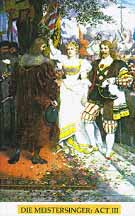Music with Ease > Operas of Richard Wagner > The Mastersingers (Wagner) - Source
The Real Mastersingers:
The Source of 'The Mastersingers'
(German title: Die Meistersinger von Nürnberg)
An Opera by Richard Wagner
Before proceeding to outline the story of Wagner’s great humorous opera, it seems expedient to give the reader some account of the real "Mastersingers" -- the artisan poets of Germany, who had a certain affinity with, and were yet entirely different from, the troubadours of France. It is not so long since the craft became extinct. Twelve old Meistersingers held regular meetings in a little inn at Ulm as late as 1830. By 1839 the number had dwindled to four; and the quartet solemnly decided that the society of Mastersingers be disbanded for ever. It is said that the last of these interesting survivals died in 1876.

Act III of Wagner's Die Meistersinger von Nürnberg, as portrayed by the illustrator, Ferdinand Leeke (1859-1925)
The Meistersingers had their origin in the early part of the fourteenth century, and their golden age was about the time of the Lutheran Reformation. A versifying mania had taken possession of the lower classes. As one historian phrases it, blacksmiths, weavers, shoemakers, doctors, and schoolmasters sought to mend their fortunes by making verses. Companies of these persons formed themselves into guilds or corporations, calling themselves "Mastersingers," and holding periodical gatherings at which they criticised each other’s productions. They composed their verses in conformity with certain strict guild rules; accuracy, industry, and painstaking care, rather than an unfettered expression of the true spirit of poetry, were the main features of the Mastersingers’ art. "Every fault was marked, and he who had the fewest faults was awarded the prize and permitted to take apprentices." When his apprenticeship was over the young man was admitted to the corporation as a full-fledged Meistersinger.
Expert writers who have studied the subject have shown that there was a guild of Meistersingers at Mainz as early as 1311. The idea caught the popular fancy, and before the fourteenth century was out, few towns in Germany were without their guild of Meistrsingers. It was, however, at Nuremberg, and in the time of Hans Sachs (1494-1575), that the school attained its highest development. Nuremberg, which still preserves much of its ancient dignity, was in fact the heart and shrine of the mastersong. The circumstance is not forgotten to-day. Pilgrims find their way to the typical, mediaeval town; visit St., Catherine’s, where the formal contests of the Meistersingers were held; see the quaintly decorated cabinet that hangs on the church wall and bears the portraits of our "Meisters", and indulge in dreams of the dead days, as they pass through the streets once tod by Albert Dürer and Hans Sachs. Who does not know Longfellow’s fine poem on Nuremberg?
Here Hans Sachs, the cobbler poet, laureate of the gentle craft,
Wisest of the Twelve Wise Masters, in huge folios sang and laughed. (...)
Vanished is the ancient splendour, and before my dreamy eye
Wave these mingled shapes and figures like a faded tapestry.
Not thy Councils, not thy Kaisers, win for thee the world’s regard,
But thy painter Albrecht Dürer, and Hans Sachs, thy cobbler-bard.
Sachs makes a considerable figure in Wagner’s comedy, and it is therefore of interest to note that he was an historical character, not a mere creature of the imagination. No fewer than 6048 works are attributed to this cobbler-bard, 4275 of which are "Meisterlieder." Whatever he touched seems to have become either music or poetry under his hand! That Wagner idealized him is obvious enough, for no shoemaker could have been the philosopher, poet, artist, commoner, and genial Romanticist that Sachs is made to appear in this engaging drama. But our only concern here is to emphasise the fact that Sachs walked the earth is his day, and took a leading part in these competitions of the Meistersingers which Wagner has so humorously satirised.
So, too, with other Meistersingers in the opera -- Pogner, Kotner, Zorn, Nachtigal, Beckmesser, and the rest -- their names are all to be found in the treatise of Christoph Wagenseil, published in 1697. From this learned tome Wagner admittedly gained his information about the old Meistersingers, their contests, and their quaint manners. But he worked up the story in his own way, to suit his own particular purpose. The charming love episode, for example, is entirely his conception, for no real-life candidate for admission to the Meistersingers’ guild ever won his bride as a prize in the song contest. This is another tribute to the dramatic genius of the master whose delightful comedy I now proceed to describe.
Music With Ease | About Us | Contact Us | Privacy | Sitemap | Copyright | Terms of Use © 2005-25 musicwithease.com. All Rights Reserved. |
